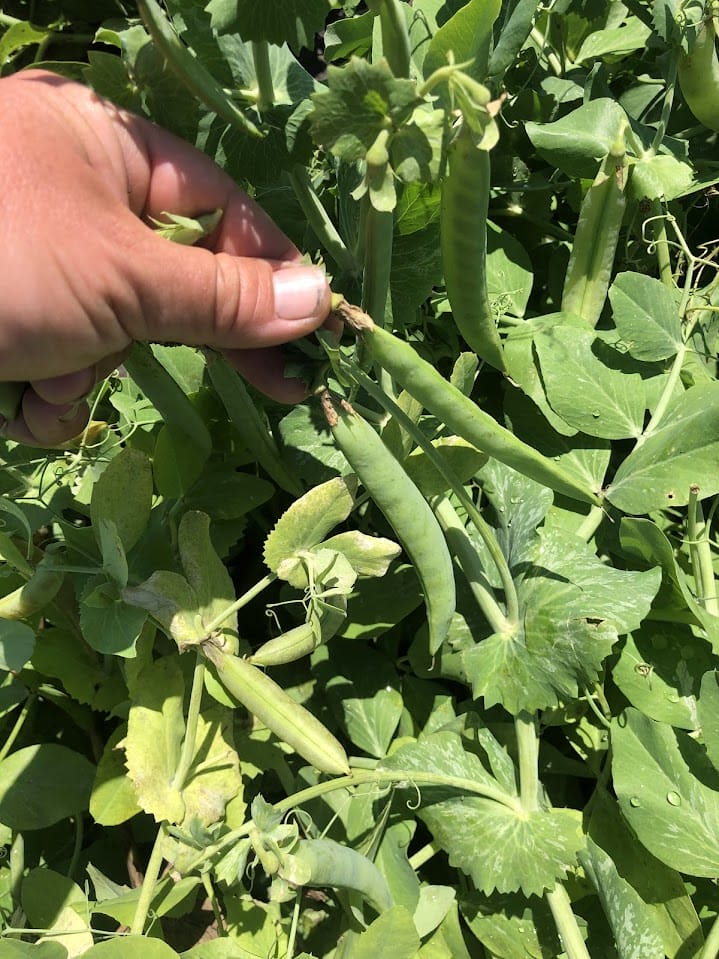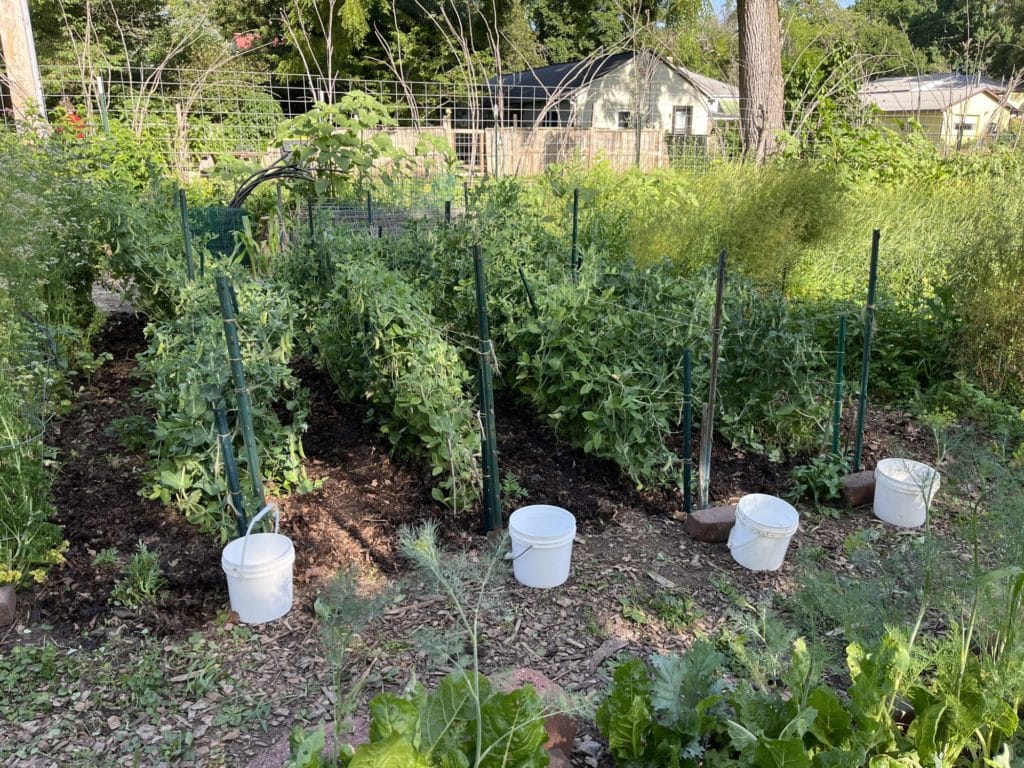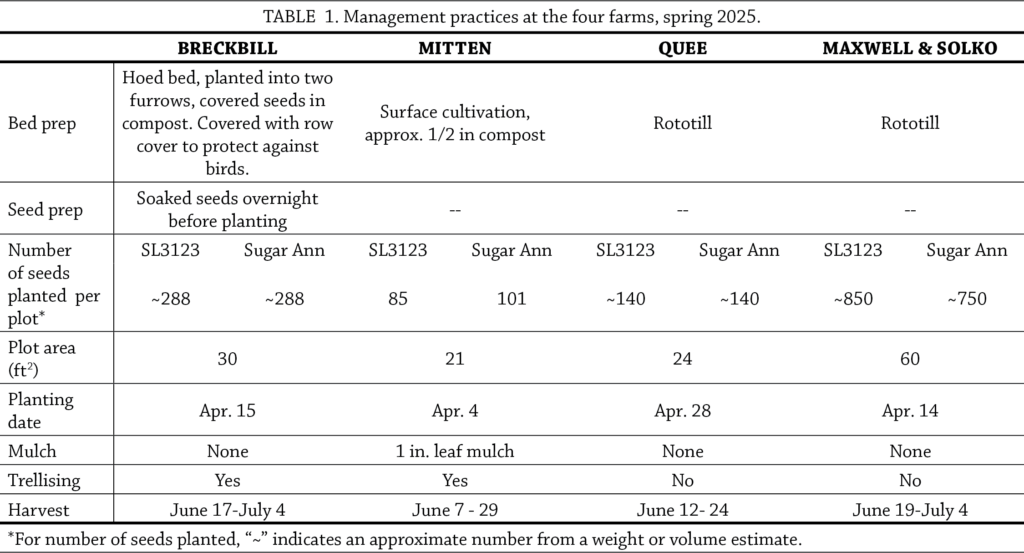In a Nutshell:
- Hannah Breckbill, Roxane Mitten, Mark Quee, and Kyle Maxwell & Kate Solko trialed newly developed snap pea variety SL3123 against the old favorite Sugar Ann.
Key Findings
- Sugar Ann performed best for Quee and Maxwell & Solko.
- Mitten saw no yield differences between the varieties but had higher rates of germination from Sugar Ann.
- SL3123 performed best for Breckbill. In fact, Breckbill’s SL3123 had the highest yield at any farm.
Background
As fast-growing, early-season legumes, snap peas can play a helpful role in a horticultural rotation. Varieties differ in their phenologies, disease resistances and vulnerabilities, interactions with pollinators, and climate and soil preferences. Horticulture operations are also diverse, differing in their climate and soil types, agronomic practices, and labor availability. Variety trials are important tools for growers to make the optimal varietal choice.
Hannah Breckbill, Roxane Mitten, Mark Quee, and Kyle Maxwell & Kate Solko were looking for snap pea varieties that produced well, tasted good, and were easy to manage. Quee wrote that “I feel like I haven’t yet really figured out spring snap pea production. Hopefully with this trial I’ll get a better sense of varietal differences and planting timing.” Solko wrote “I am looking to increase my bush pea production, and this trial will help me understand yield expectations going forward and select the most productive varieties within my systems. [I also want] a better understanding of whether trellising peas is important.” All the cooperators settled on growing two varieties to compare in this trial:
Sugar Ann is an open pollinated (OP) classic—it won the All-American Selection prize in 1984—that is known for its sweet taste and short growing season [1], [2]. A bush variety, it can be grown free-standing, although it is suggested that trellising might increase yield.
SL3132 is a new OP variety developed by Syngenta [3]. It was selected for stress tolerance. Both varieties are listed as dwarves, opening the possibility of growing them without trellising.
Methods
Design
For this trial all four participating farms agreed to grow the same two snap pea varieties in the spring of 2025. They compared the classic standby OP variety Sugar Ann with a newly developed variety from Syngenta, SL3123.
Detailed management information for their various operations is available in Table 1. The growers planted four replicate plots of each variety. Each site made their own decisions on how many seeds to plant. For a sample plot layout, see Figure A1.
Measurements
Cooperators weighed the total amount of pea pods harvested from each plot over the course of two to three weeks. From reported plot dimensions and sowing densities, we calculated yield per square foot and yield per seed sown.
Quee estimated the number of seeds in each plot, then evaluated each plot’s germination via a qualitative scale. (‘No germination’ through ‘Very good germination’).
Mitten conducted a germination test before planting. She soaked 25 seeds of each variety, wrapped them in damp paper towel in a plastic bag, then counted the number of seeds that germinated. Based on the number of seeds that germinated in her test, she scaled the number of seeds she planted to ideally get a target population of 80 plants per plot. She then counted the actual number of plants in the plot.
Mitten and Maxwell & Solko also reported their quality assessments of the varieties’ peas.
Data analysis
We used Student’s t-test at a 95% confidence level to determine if there were significant differences between Sugar Ann and SL3123 at each farm. A t-test is used to determine if the measured values of two groups differ from each other significantly and takes into account variability seen in the replicates. 95% confidence means that if the trial were repeated in the same way we would expect to see the same results 95 times out of 100. We can perform this statistical analysis because the cooperators used completely randomized and replicated experimental designs (Figure A1).
Results and Discussion
Snap pea yield
Sugar Ann performed best for Quee and Maxwell & Solko, while Breckbill had significantly higher yield from SL3123 (Figure 1). Mitten on the other hand, saw no differences between the two varieties. Breckbill’s SL3123 yield of 0.31 lb/ft2 were the highest of either variety at any farm (Figure 1). Although comparisons between farms cannot be analyzed statistically, the two farms that trellised their peas (Breckbill, Mitten) had higher yields than those two which did not. Breckbill averaged 0.26 lb/ft2; Mitten averaged 0.22 lb/ft2; Maxwell & Solko averaged 0.02 lb/ft2; Quee averaged 0.11 lb/ft2.
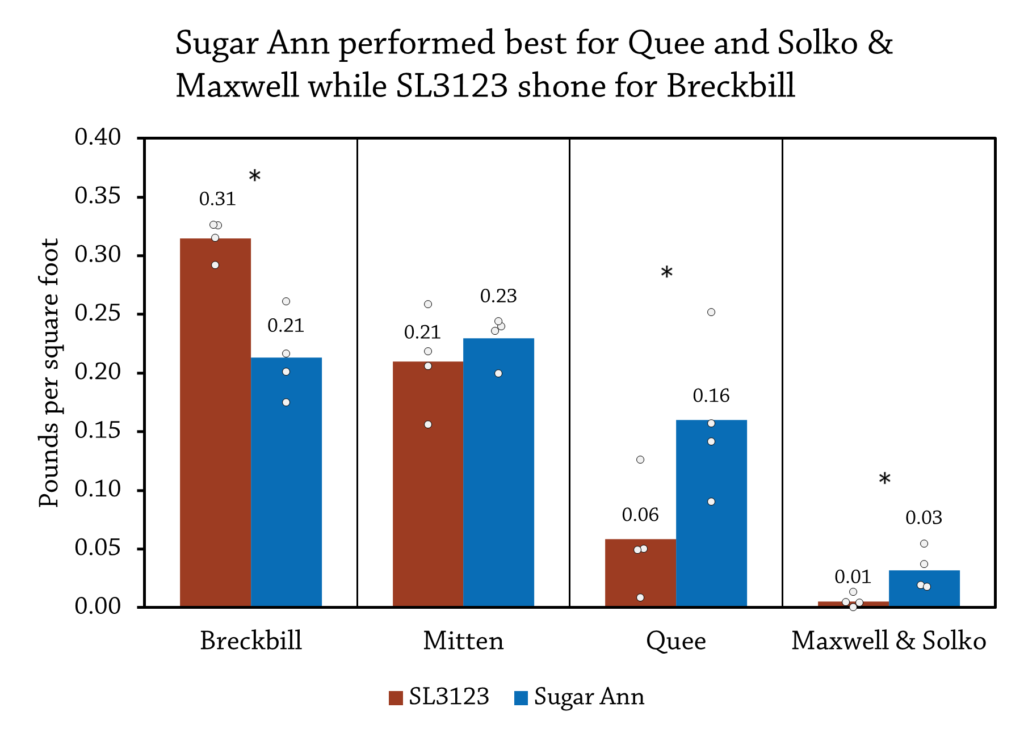
Figure 1. Snap pea yields at the four participating farms in 2025. Bars represent variety means at each farm; dots represent the yield from individual plots. Asterisks (*) indicate farms where significant differences were detected between varieties at the 95% confidence level.
Quee and Maxwell & Solko both commented on the disappointing yields of their snap peas this spring. Wildlife and weather killed off many plants. Quee plowed under a second succession that he had planted because they were stressed by the early heat.
Growing season/phenology
Sugar Ann is known for its short growing season. Johnny’s Seed lists it as taking 51 days to mature [1]. Syngenta lists SL3123 as taking an average of 70 days to mature [3]. This general trend, of Sugar Ann leading SL3123 to maturity was observed at three of the four farms. Mitten made a note of the different varieties differing phenologies: on June 23, towards the end of her harvest, the calyxes of the Sugar Ann pods were all faded or brown-tinged, while SL3123 calyxes were still green. Sugar Ann harvest peaked three days before SL3123 for Quee, and seven days earlier for Mitten. The exception to this trend of Sugar Ann maturing earlier was at Breckbill’s, whose harvest records over time show both varieties beginning and peaking (peaking on June 24) at the same time.
Germination
Quee evaluated the stand germination for each plot, ranging from “no germination” to “very good germination”. He found that Sugar Ann had better germination than SL3123, but the qualitative nature of the observation precludes analysis.
Mitten counted the number of seeds that she planted, then counted the number of plants that emerged in each plot. This allowed us to calculate the germination rate for each plot. Sugar Ann (2.96 plants/ft2) germinated significantly better than SL3123 (1.55 plants/ft2) for Mitten, mirroring Quee’s qualitative observations. Taking both Mitten’s yields (Figure 1) and germination rates into account, yield per SL3123 plant exceeded that of Sugar Ann by over 40% (2.18 oz/plant vs. 1.25 oz/plant, respectively).
Conclusions and Next Steps
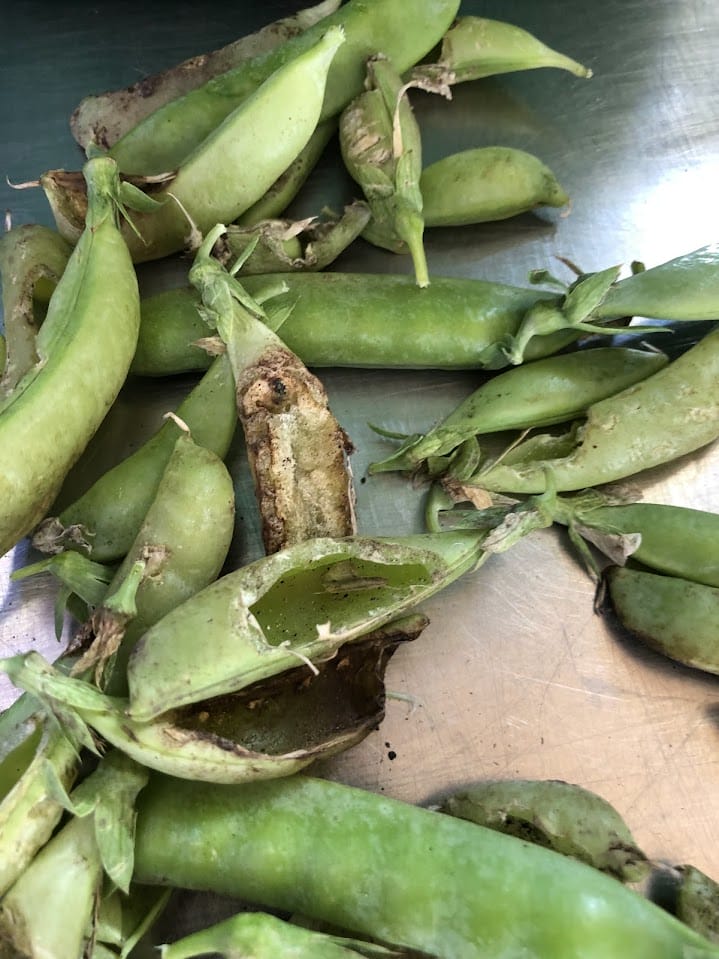
Gnawed and trampled: this photo shows a small sampling of the pea pods lost to wildlife that likely reduced yields at Root to Rise Farm. Photo taken June 2025.
Cooperators’ conclusions about the trial were mixed. Breckbill and Mitten trellised their peas and had the two highest average yields. Quee and Maxwell & Solko did not trellis; they were hoping to identify a variety that flourishes without the additional input of labor and material. Quee wrote: “Nothing about this made me want to scale up my snap pea production. Still a big challenge for us, even when I have to pay special attention. Shell and snows did great for us this year, but snaps continued to be a struggle.”
Breckbill was happy to find a new variety that yielded so well. Mitten commented that SL3123 was totally string-less, which was very nice for preparation.
Although losses to wildlife pressure and wet weather meant that they could not come to a definite conclusion about how beneficial trellising might be for Maxwell & Solko, they were firm that they would be sticking with Sugar Ann, which germinated, grew, and tasted better for them.
Appendix – Trial Design and Weather Conditions

Figure A1. An example of the random, replicated experimental design used by Breckbill, Mitten, Quee, and Maxwell & Solko.
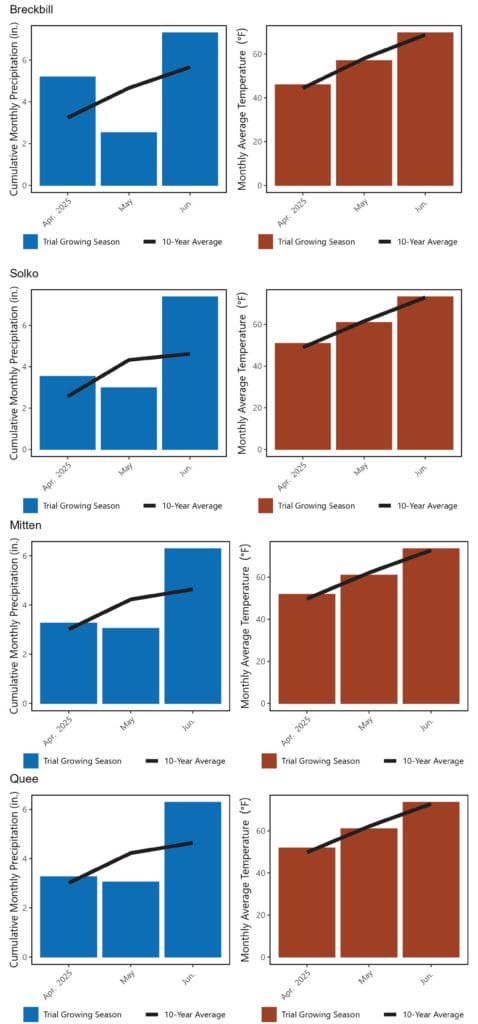
Figure A2. Modelled mean monthly temperature and rainfall at the four trial sites during the study period and the ten-year historic averages. Data is from the NasaPOWER climate dataset [4], [5]
References
[1] “Sugar Ann – Pea Seed | Johnny’s Selected Seeds.” Accessed: Sep. 16, 2025. [Online]. Available: https://www.johnnyseeds.com/vegetables/peas/snap-peas/sugar-ann-pea-seed-559.html?srsltid=AfmBOopw15Gyx0bTqWuV9ZHvV89Hu0SCYdc_vsvUPU2Z65aFfJC6QVhC
[2] V. S. Company, “Sugar Ann Sugar Snap Pea – Victory Seeds®,” Victory Seed Company. Accessed: Sep. 16, 2025. [Online]. Available: https://victoryseeds.com/products/sugar-ann-sugar-snap-pea
[3] “SL3123,” Syngenta Vegetable Seeds US. Accessed: Sep. 22, 2025. [Online]. Available: https://www.syngentavegetables.com/en-us/product/seed/pea/sl3123
[4] A. Sparks, _nasapower: NASA-POWER Data from R_. (2024). [Online]. Available: https://CRAN.R-project.org/package=nasapower
[5] A. H. Sparks, “nasapower: A NASA POWER Global Meteorology, Surface Solar Energy and Climatology Data Client for R,” J. Open Source Softw., vol. 3, no. 30, p. 1035, Oct. 2018, doi: 10.21105/joss.01035.


